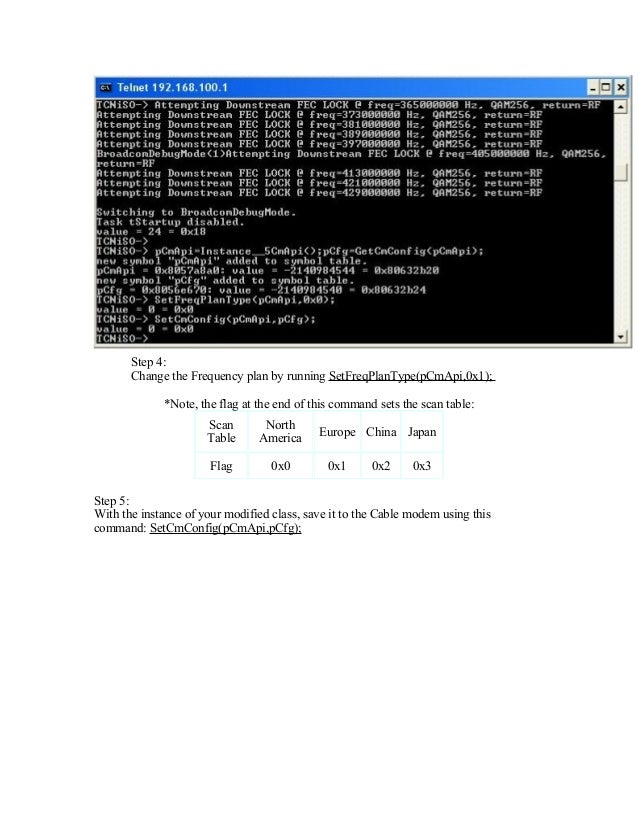Excentis Cable Modem Config File Editor For Mac
Contents Contents. History DOCSIS was developed by and contributing companies including,. The first specification was version 1.0, issued in March 1997, with revision 1.1 (adding (QoS) capabilities) following in April 1999.
Because of increased demand for symmetric services such as IP telephony, DOCSIS was revised to enhance upstream transmission speeds; DOCSIS 2.0 was released in December 2001. Most recently, the specification was revised to significantly increase transmissions speeds (this time both upstream and downstream) and introduce support for (IPv6). This version, DOCSIS 3.0, was released in August 2006. Cross-version compatibility has been maintained across all versions of DOCSIS, with the devices falling back to the highest supported version in common between both endpoints: and (CMTS).
For example, if one has a cable modem that only supports DOCSIS 1.0, and the system is running 2.0, the connection will be established at DOCSIS 1.0 speeds. As of the end of 2011, the fastest deployments in North America are expected to be 's announced 250 Mbit/s download 15 Mbit/s upload, which will be implemented in phases, and's 120 Mbit/s download / 20 Mbit/s upload service infollowed closely by existing 107 Mbit/s deployments in the USA. (FCC) urged U.S. Providers to make 100 Mbit/s a standard speed available to 100 million households before 2020. Of wired technologies, only DOCSIS, (advanced with bandwidth equivalent to fiber) and are likely to achieve this speed on large scale in that time frame. In the UK, broadband provider announced on 20 April 2011 an intention to start trials with download speeds of 1.5 Gbit/s and upload of 150 Mbit/s based on DOCSIS3.0.
Regional variants As frequency allocation bandwidth plans differ between United States and European systems, DOCSIS standards have been modified for use in Europe. These modifications were published under the name 'EuroDOCSIS'. The differences between the bandwidths exist because European cable TV conforms to standards of 8 MHz bandwidth and North American cable TV conforms to standards which specify 6 MHz.
The wider bandwidth in EuroDOCSIS architectures permits more bandwidth to be allocated to the downstream data path (toward the user). EuroDOCSIS certification testing is executed by Belgian company Excentis (formerly known as tComLabs), while DOCSIS certification testing is executed. Typically, receives 'certification', while equipment receives 'qualification'.
Excentis Cable Modem Config File Editor For Mac Mac
Most cable systems in Japan and Colombia utilize the North American version of DOCSIS, while some employ a variant of DOCSIS that uses upstream channels that are based on a 9.216 MHz master clock (as opposed to 10.24 MHz used in DOCSIS/EuroDOCSIS) resulting in upstream channel widths that are a power-of-two division of 6 MHz (as opposed to 6.4 MHz in DOCSIS/EuroDOCSIS). International standards The (ITU-T) has approved the various versions of DOCSIS as international standards. DOCSIS 1.0 was ratified as ITU-T Recommendation J.112 Annex B (1998), but it was superseded by DOCSIS 1.1 which was ratified as ITU-T Recommendation Annex B (2001). Subsequently, DOCSIS 2.0 was ratified as ITU-T Recommendation. Most recently, DOCSIS 3.0 was ratified as ITU-T Recommendation J.222 (, ). Note: While ITU-T Recommendation J.112 Annex B corresponds to DOCSIS/EuroDOCSIS 1.1, Annex A describes an earlier European cable modem system (' EuroModem') based on ATM transmission standards. Annex C describes a variant of DOCSIS 1.1 that is designed to operate in Japanese cable systems.
The ITU-T Recommendation J.122 main body corresponds to DOCSIS 2.0, J.122 Annex F corresponds to EuroDOCSIS 2.0, and J.122 Annex J describes the Japanese variant of DOCSIS 2.0 (analogous to Annex C of J.112). Features DOCSIS provides great variety in options available at (OSI) layers 1 and 2, the and layers. Channel width: All versions of DOCSIS utilize either 6 MHz channels (e.g. North America) or 8 MHz channels ('EuroDOCSIS') for downstream transmission.

In the upstream, DOCSIS 1.0/1.1 specifies channel widths between 200 kHz and 3.2 MHz. DOCSIS 2.0 also specifies 6.4 MHz, but can use the earlier, narrower channel widths for backward compatibility. Modulation: All versions of DOCSIS specify that 64-level or 256-level (64-QAM or 256-QAM) be used for modulation of downstream data, utilizing the J.83-AnnexB standard for 6 MHz channel operation, and the modulation standard for 8 MHz (EuroDOCSIS) operation. Upstream data uses or 16-level QAM (16-QAM) for DOCSIS 1.x, and it uses QPSK, 8-QAM, 16-QAM, 32-QAM, 64-QAM for DOCSIS 2.0 & 3.0. DOCSIS 2.0 & 3.0 also support 128-QAM with in mode (with an effective equivalent to that of 64-QAM). DOCSIS employs a mixture of deterministic access methods for upstream transmissions, specifically for DOCSIS 1.0/1.1 and both and for DOCSIS 2.0 and 3.0, with a limited use of contention for bandwidth requests. In contrast to the pure contention-based MAC employed in older systems (there is no contention in ), DOCSIS systems experience few collisions.
For DOCSIS 1.1 and above the MAC layer also includes extensive (QoS) features that help to efficiently support applications that have specific traffic requirements such as low latency, e.g. DOCSIS 3.0 features, which enables multiple downstream and upstream channels to be used together at the same time by a single subscriber. Throughput All of these features combined enable a total upstream throughput of 30.72 per 6.4 MHz channel, or 10.24 per 3.2 MHz channel. All three versions of the DOCSIS standard support a downstream throughput with 256-QAM of up to 42.88 per 6 MHz channel, or 55.62 per 8 MHz channel for EuroDOCSIS. (see table below). DOCSIS modems are managed via an address.
DOCSIS 3.0 adds management over.
Overview SURFboard DOCSIS Cable Modem Configuration File Editor is a Shareware software in the category Education developed. The latest version of SURFboard DOCSIS Cable Modem Configuration File Editor is currently unknown. It was initially added to our database on. SURFboard DOCSIS Cable Modem Configuration File Editor runs on the following operating systems: Windows.

SURFboard DOCSIS Cable Modem Configuration File Editor has not been rated by our users yet. For SURFboard DOCSIS Cable Modem Configuration File Editor!